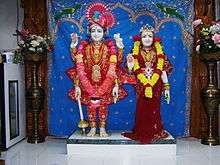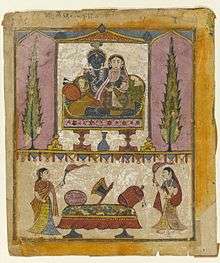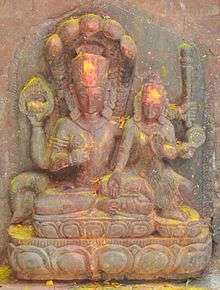Lakshmi Narayan
Lakshmi Narayan or Lakshmi-Narayana (Sanskrit: लक्ष्मी-नारायण, IAST: Lakṣmīnārāyaṇa), also sometimes spelled Lakshminarayan, Lakshminarayana, Laxminarayana, is a manifestation of Vishnu in the Hindu religion. It is usually referring to Vishnu, also known as Narayan, when he is with his consort, Lakshmi, in his abode, Vaikuntha. The goddess of beauty Lakshmi is depicted as standing next to a dark-skinned Vishnu, who is holding a conch, mace, lotus and the Sudarshana Chakra. Another depiction of Lakshminarayan portrays Lakshmi in the service of Narayan, who is reclining on the cosmic serpent Sesha, floating in Kshīrsagār, the Ocean of Milk.[1]
| Lakshmi Narayan | |
|---|---|
Existence | |
 LakshmiNarayan Dev Murtis at the Swaminarayan Temple in Downey, California | |
| Devanagari | लक्ष्मी-नारायण |
| Sanskrit transliteration | Lakṣmīnārāyaṇa |
| Affiliation | Form of Vishnu and his consort Lakshmi |
| Abode | Vaikuntha |
| Weapon | Conch, Club, Disc-Weapon |
| Mount | Garuda |
Interpretations
The deity Lakshminarayan has many historic roots and is sometimes interpreted by different traditions. Goddess Mahalakshmi incarnated again and again with Her beloved consort following Narayana's wish and mode of incarnation. When He was Rama, She became Sita and when He was Krishna, She appeared as Radha. Other queens were Her expansions. This fact is explored in Ramayana, Mahabharata, Vishnu purana, Bhagavat purana and in other authentic scriptures. Goddess Subhadra was treated as Lakshmi during the Ganga period, and afterwards. The Purushottama Mahatmya of Skanda Purana (13th century A.D.) and of Vishnurahasya (16th century A.D.) referred to the female wooden image between Jagannath and Balabhadra, Subhadrā as Lakshmi.[2]

In Swaminarayan Sampraday
In sect Swaminarayan Sampraday, the deity is referred to as Laxminarayan Dev.
Krishna — identified with Narayana in the text Shikshapatri — is with his wife Rukmini, a form of Lakshmi, and is also called LaxmiNarayan Dev.[3] The founder of the sect, Swaminarayan installed the murtis of Laxminarayan Dev at the Swaminarayan Mandir, Vadtal.
Worship
Lakshmi Narayana worship is very popular with the people, who pray to the Lord at their homes and in temples. There are many Sampradhays or sects, which regard Lakshmi Narayana as the ultimate divinity, and grand and exquisite temples have been erected for the Lord accordingly, at many places. Lakshmi Narayan temple, popularly known as Birla Mandir, in New Delhi is one such well-known temple. It is believed that worshiping Lord Lakshmi Narayana can get for the devotees the complete blessings of the divine couple and shall bestow welfare, success, prosperity and a fulfilled life for the devotees and their families.[4]
See also
- Sri Sampradaya
- Vaishnavism
- Laxminarayan Temple, New Delhi
References
- Ellwood, Robert (2007). Encyclopedia of World Religions. New York: Infobase Publishing. pp. 468. ISBN 0-8160-6141-6.
- Dr. A.C. Pradhan (June 2004). "Evolution of Jagannath Cult" (PDF). Archived from the original (PDF) on 2009-03-04. Retrieved 2008-05-11. Cite journal requires
|journal=(help) - "Shikshapatri, verse 109 by Swaminarayan".
- "Benefits of praying to Lord Lakshmi Narayana, About Lord Lakshmi Narayana - Astropedia". www.astroved.com. Retrieved 2020-01-06.
Serials
Shree Lakshmi Narayan-A Marathi Language Mythological Serial story of Goddess Lakshmi and Lord Narayan on Colors Marathi.Serial stared at 27 May 2019 And serial completes 140 episodes on 2 November 2019. Namah Lakshmi Narayan -A Mythological Hindi Language Serial Story of Goddess Lakshmi and Lord Narayan on Star Plus. Serial started at 23 September 2019 and And serial completes 66 episodes On 20 December 2019.

_in_the_Hoysaleshwara_temple_at_Halebidu.jpg)

